NCERT Solution: Motion
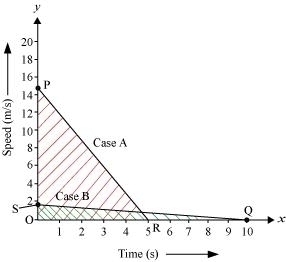
Distance Travelled by first car before coming to rest =Area of △ OPR
= (1/2) � OR � OP
= (1/2) � 5s � 52 kmh−1
= (1/2) � 5 � (52 � 1000) / 3600) m
= (1/2) � 5 � (130 / 9) m
= 325 / 9 m
= 36.11 m
Distance Travelled by second car before coming to rest =Area of △ OSQ
= (1/2) � OQ � OS
= (1/2) � 10 s � 3 kmh−1
= (1/2) � 10 � (3 � 1000) / 3600) m
= (1/2) � 10 x (5/6) m
= 5 � (5/6) m
= 25/6 m
= 4.16 m
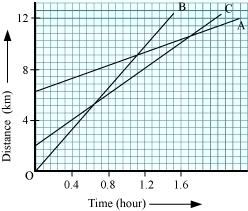
(a) Which of the three is travelling the fastest?
(b) Are all three ever at the same point on the road?
(c) How far has C travelled when B passes A?
(d)How far has B travelled by the time it passes C?
Answer
(a) Object B
(b) No
(c) 5.714 km
(d) 5.143 km
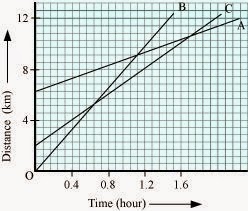
![]()
![]()
Therefore, Speed = slope of the graph
Since slope of object B is greater than objects A and C, it is travelling the
fastest.
(b) All three objects A, B and C never meet at a single point. Thus, they were
never at the same point on road.
(c)
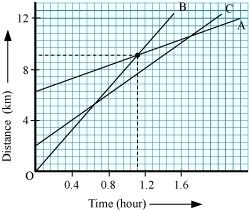
7 square box = 4 km
∴ 1 square box = 4/7 km
C is 4 blocks away from origin therefore initial distance of C from origin =
16/7 km
Distance of C from origin when B passes A = 8 km
Thus, Distance travelled by C when B passes A = 8 - 16/7 = (56 - 16)/7 = 40/7 =
5.714 km
(d)
Distance travelled by B by the time it passes C = 9 square boxes
9�4/7 = 36/7 = 5.143 km
Let us assume, the final velocity with which ball will strike the ground be
'v' and time it takes to strike the ground be 't'
Initial Velocity of ball, u =0
Distance or height of fall, s =20 m
Downward acceleration, a =10 m s-2
As we know, 2as =v2-u2
v2 = 2as+ u2
= 2 x 10 x 20 + 0
= 400
∴ Final velocity of ball, v = 20 ms-1
t = (v-u)/a
∴Time taken by the ball to strike = (20-0)/10
= 20/10
= 2 seconds
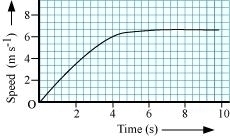
(a) Find out how far the car travels in the first 4 seconds. Shade the area on the graph that represents the distance travelled by the car during the period.
(b) Which part of the graph represents uniform motion of the car?
Answer
(a)
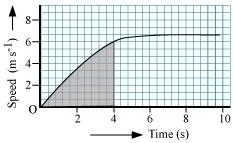
The shaded area which is equal to 1/2 � 4 � 6 = 12 m represents the distance travelled by the car in the first 4 s.
(b)
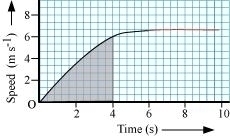
The part of the graph in red colour between time 6 s to 10 s represents uniform motion of the car.
State which of the following situations are possible and give an example for each of these:
(a) an object with a constant acceleration but with zero velocity.
(b) an object moving in a certain direction with an acceleration in the perpendicular direction.
Answer
(a) Possible
When a ball is thrown up at maximum height, it has zero velocity, although it will have constant acceleration due to gravity, which is equal to 9.8 m/s2.
(b) Possible
When a car is moving in a circular track, its acceleration is perpendicular to its direction.
Radius of the circular orbit, r = 42250 km
Time taken to revolve around the earth, t= 24 h
Speed of a circular moving object, v = (2π r) / t
= [2× (22/7)×42250 × 1000] / (24 × 60 × 60)
= (2×22×42250×1000) / (7 ×24 × 60 × 60) m s-1
= 3073.74 m s-1
circle would be:
(a) Zero
(b) πr
(c) 2r
(d) 2πr
Ans. (c) 2r
Explanation: After half a circle, the particle will be diametrically opposite to its origin.
Hence, displacement is equal to diameter.
2. A body is thrown vertically upward with velocity u, the greatest height h to which it
will rise is,
(a) u/g
(b) u2/2g
(c) u2/g
(d) u/2g
Ans. (b) u2/2g
3. The numerical ratio of displacement to distance for a moving object is
(a) always less than 1
(b) always equal to 1
(c) always more than 1
(d) equal or less than 1
Ans. (d) equal or less than 1
Explanation: Displacement can be equal or less than distance but it will never be more than distance.
4. If the displacement of an object is proportional to square of time, then the
object moves with
(a) uniform velocity
(b) uniform acceleration
(c) increasing acceleration
(d) decreasing acceleration
Ans. (b) uniform acceleration
Explanation: Velocity is measured in terms of distance per second, while
acceleration is measured in terms of distance per square second.
Hence, uniform acceleration is the correct answer.
5. From the given v � t graph (Fig. 8.1), it can be inferred that the object is
(a) in uniform motion
(b) at rest
(c) in non-uniform motion
(d) moving with uniform acceleration
Ans. (a) in uniform motion
Explanation: Straight horizontal line which is above zero on x-axis; shows
uniform motion.
6. Suppose a boy is enjoying a ride on a merry-go-round which is moving with a
constant speed of 10 ms�1. It implies that the boy is
(a) at rest
(b) moving with no acceleration
(c) in accelerated motion
(d) moving with uniform velocity
Ans. (c) in accelerated motion
Explanation: A boy on a merry-go-around is in circular motion. Circular motion
is an example of acceleration motion.
7. Area under a v � t graph represents a physical quantity which has the
unit
(a) m2
(b) m
(c) m3
(d) ms�1
Ans. (b) m
Explanation: The given area represents displacement. Unit of displacement is
meter.
8. Four cars A, B, C and D are moving on a levelled road. Their distance versus
time graphs are shown in Fig. 8.2. Choose the correct statement
(a) Car A is faster than car D.
(b) Car B is the slowest.
(c) Car D is faster than car C.
(d) Car C is the slowest.
Ans. (b) Car B is the slowest.
Explanation: Graph for car B attains least height (on x-axis) in the given time.
Hence, it is the slowest car
9. Which of the following figures (Fig. 8.3) represents uniform motion of a
moving object correctly?
Ans. (a)
Explanation: Distance is increasing at a uniform rate; as shown by upward
slanting
straight line. Hence, this graph shows uniform motion.
10. Slope of a velocity � time graph gives
(a) the distance
(b) the displacement
(c) the acceleration
(d) the speed
Ans. (c) the acceleration
11. In which of the following cases of motions, the distance moved and the
magnitude of displacement are equal?
(a) If the car is moving on straight road
(b) If the car is moving in circular path
(c) The pendulum is moving to and fro
(d) The earth is revolving around the Sun
Ans. (a) If the car is moving on straight road
Explanation: In all other class, displacement can be less than distance.
When the displacement is zero, it does not mean that distance is also zero. Displacement can be zero when the moving object comes back to its original position. Displacement is either equal to or less than distance but distance travelled is always more than zero.